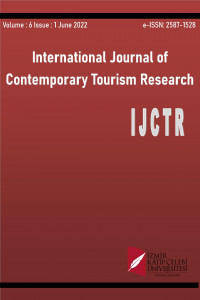TERMAL TURİZMDE YERLİ TURİSTLERİN SEYAHAT MOTİFLERİ VE HİZMET BEKLENTİLERİ
Termal turizm, son dönemlerde ulusal ve uluslararası turistler düzeyinde sağlık ve tedavi başta olmak üzere rahatlama, kaçış ve dinlenme gibi nedenlerle talep edilen bir turizm çeşidi olarak değerini artırmaktadır. Bu anlamda termal turizm destinasyonlarının rekabet gücünü artırma ve turistlerin destinasyonlara tekrar ziyaretini sağlama adına bilimsel araştırmalar önem kazanmaktadır. Bu çalışmada, termal turizme katılma amacıyla seyahate çıkan yerli turistlerin seyahat motifleri ve termal tesis hizmet beklentilerinin ortaya çıkarılması ve arasındaki ilişkinin test edilmesi amaçlanmaktadır. Bu amaç doğrultusunda Haymana Kaplıcaları'na ziyaret gerçekleştiren 408 yerli turiste, Eylül 2016-Ocak 2017 döneminde veri toplamak amacıyla anket uygulanmıştır. Anket verilerinin analizi kapsamında yerli turistlerin seyahat motifleri; sağlık (x=4,45), rahatlama (x=4,46), kaçış (x=4,16) ve prestij ve eğlence (x=2,28), öncelik sırasında şekillenmiştir. Termal tesis hizmet beklentileri ise termal tesislerde kullanım alanlarının ve verilen araç gereçlerin temizliği, suyun sıcaklık derecesi ve kalitesi, çalışan personelin nitelikli olması, hizmet sunan personelin hijyen kurallarına uyması, sunulan hizmet kalitesi, termal tesisin sakinliği, tesislerde sağlık personeli bulundurulması, kaplıca suyuyla ilgili ayrıntılı bilgi verilmesi ve tesislerde dinlenme salonlarının bulunması özelinde gerçekleşmiştir.Ayrıca termal turistlerin seyahat motifleri ile termal tesis hizmet beklentisi ilişkisine yönelik gerçekleştirilen Korelasyon Analizi kapsamında düşük düzeyde pozitif yönlü anlamlı bir ilişki (r=0,298; p=0,000) tespit edilmiştir.
Anahtar Kelimeler:
Termal turizm, yerli turist, seyahat motifi, hizmet beklentisi
TRAVEL MOTIVES AND SERVICE EXPECTATION OF DOMESTIC TOURISTS IN THERMAL TOURISM
At the last periods, thermal tourism has enhanced its value as a requested type of tourism in terms of particularly health and treatment, than relaxing, escaping and resting at the both national and international levels. In this sense, scientific researches related to thermal tourists has become crucial owing to enhancing the competitive power and providing journey repetition for the tourists. In this study, the main aim is revealing the journey motives of domestic tourists who prefer their journey with thermal theme, their expectations from the thermal facility services and the relationship between both. Accorging to this aim, in order to collect valid data, survey was applied to 408 domestic tourists who had visited Haymana Hot Springs between the period of September 2016 to January 2017. Within the context of analysis of the survey data, journey of domestic tourists is shaped respectively as health (x=4,45), relaxing (x=4,46), escaping (x=4,16), prestige and entertainment. The expectations from the thermal facility services occur with the usage areas of the facilities, the cleanliness of the equipments provided, the degree and quality of hot water, qualified serving personnels who obey to hygenic rules, quality of service and products, calmliness of thermal facility, keeping medical personnel at the facility, presenting detail information about the hot spring water and locating resting saloons. Also, as part of Correlation Analysis applied for relationship between thermal tourists’ journey motives and expectation of thermal facility, a low level positive directional and significant relationship (r=0,298; p=0,000) is determined.
Keywords:
Thermal tourism, domestic tourist, travel motive, service expectation,
___
- Ayaz, N. (2012). Kırsal Turizm ve Paydaşları: Belediye Başkanlarının Tutumlarına Yönelik Bir Araştırma. Yayımlanmamış Doktora Tezi, Gazi Üniversitesi Eğitim Bilimleri Enstitüsü Ankara. Boekstein, M. (2014). Tourism, health and the changing role of thermal springs- should South Africa reposition its thermal spring tourism product? African Journal of Hospitality, Tourism and Leisure, 3(2), 1-9. Chang, J. C. (2007). Travel motivations of package tour travelers. Tourism, 55(2), 157-176. Dimitrovski, D. & Todorović, A. (2015). Clustering Wellness Tourists in Spa Environment. Tourism Management Perspectives, (16), 259-265. GDFHTS-R (2010). Developments and Challenges in The Hospitality and Tourism Sector. International Labour Office Switzerland. Goeldner, C. R., Ritchie, J. R. B. ve McIntosh, R. W. (2000). Tourism Principles Practices Philosophies. (Eighth Edition). New York. İncekara, A. (1996). Sağlık Turizminde Jeo-Termal Kaynaklar. İstanbul: İTO Yayınları. Jafari, J. (2000). Encyclopedia of Toursim. Londan-New York: Routledge. Kültür ve Turizm Bakanlığı (2007). Türkiye Turizm Stratejisi 2023. Ankara: Kültür ve Turizm Bakanlığı Yayınları. Özdemir, Ş. (2015). Türkiye’nin Termal Sağlık Turizmi Potansiyeli. M. Altındiş (Editör). Termal Turizm (s.1-12), Ankara: Nobel Akademik Yayıncılık Eğitim Danışmanlık Tic. Ltd. Şti. Pongrác A. & Laczko T. (2008). Spatial Concentration of Hungary’s Health Tourism. Modern Geografia, (2), 1-22. Rodnic, A. R., Gracan, D., ve Fister, M. (2009). Repositioning of Thermal Spa Tourism of Nort-West Crotia in Accordance With the Europea Thermal Spa Torism Trends. Tourism and Hospitality Management an International Journal of Multidisciplinory Researc, Vienna. Sarıışık, M. (1994). Türkiye’de Termal Turizmi ve Sandıklı (Afyon) Bölgesi Örneği, YayınlanmamışYüksek Lisans Tezi, Akdeniz Üniversitesi/Sosyal Bilimler Enstitüsü, Antalya. Taskov, N., Metodijeski, D., ve Mitreva, E. (2015). Thermal Tourism in Macedonia. Germany: LAP LAMBERT Academic Publishing. Toskay, T. (1989). Turizm-Turizm Olayına Genel Yaklaşım. İstanbul: Der Yayınları. Vuuren, C. V. ve Slabbert, E. (2011). Travel motivations and behaviour of tourists to a South African resort. Book of Proceedings I (p.295-304), International Conference on Tourism & Management Studies-Algarve 2011. Yazıcıoğlu, Y. ve Erdoğan, S. (2011). SPSS Uygulamalı Bilimsel Araştırma Yöntemleri. Ankara: Detay Yayıncılık.
- Başlangıç: 2016
- Yayıncı: İzmir Katip Çelebi Üniversitesi
Sayıdaki Diğer Makaleler
TERMAL TURİZMDE YERLİ TURİSTLERİN SEYAHAT MOTİFLERİ VE HİZMET BEKLENTİLERİ
THE CONSUMPTION OF LOCAL FOOD IN RESTAURANTS: A STUDY IN KAS
AVRUPA’DAN TÜRKİYE’YE YÖNELİK TURİZM AKIMLARININ PANEL ÇEKİM MODELİ İLE ANALİZİ
YERLİ ZİYARETÇİLERİN ÇEVRESEL SÜRDÜRÜLEBİLİRLİK ALGISININ BELİRLENMESİNE YÖNELİK BİR ARAŞTIRMA
Turizm Öğrencilerinin Etik Bilinci, Niyeti ve Yöneliminin Çok Boyutlu Bir Analizi
